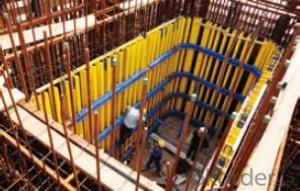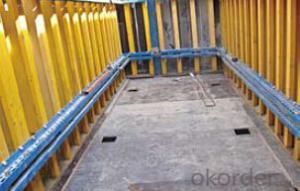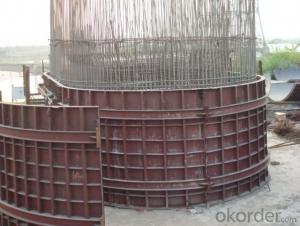Shaft-platform system for Formwork and Scaffolding
- Loading Port:
- Tianjin
- Payment Terms:
- TT OR LC
- Min Order Qty:
- 50 m²
- Supply Capability:
- 1000 m²/month
OKorder Service Pledge
Quality Product, Order Online Tracking, Timely Delivery
OKorder Financial Service
Credit Rating, Credit Services, Credit Purchasing
You Might Also Like
Shaft Platform
As operating platform, the shaft platform is mainly used in the concrete pouring of elevator shaft,
equipment shaft, stair shaft of high-rise building and so on.
Characteristics:
◆ The length of shaft beam is adjustable.
◆ Flexible structure makes lifting easier.
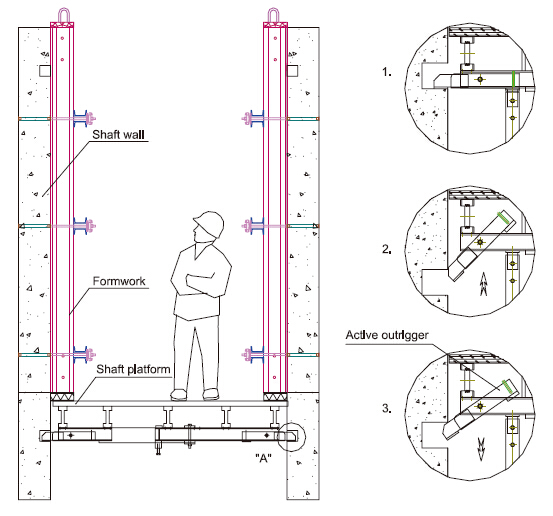
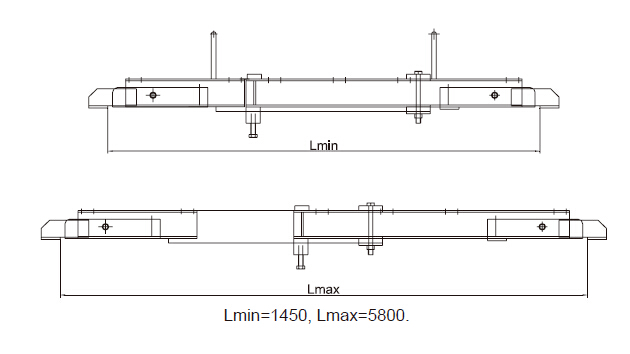
- Q: What are the different locking mechanisms used in steel formwork?
- There are several different locking mechanisms used in steel formwork to ensure stability and integrity during concrete construction projects. These mechanisms are designed to securely hold the formwork panels together and prevent any shifting or movement that may compromise the accuracy and quality of the final concrete structure. One commonly used locking mechanism is the wedge clamp system. This system consists of steel wedges that are inserted between the formwork panels and tightened using a hammer or mallet. The wedges create a strong connection between the panels, holding them tightly in place. Another popular locking mechanism is the pin and wedge system. This system involves the use of steel pins that are inserted through holes in the formwork panels. Then, steel wedges are driven into the holes, securing the pins in place. This creates a stable and secure connection between the panels. Some steel formwork systems also utilize a hook and loop mechanism. This involves the use of metal hooks that are attached to one panel and metal loops that are attached to the adjacent panel. The hooks and loops interlock, providing a strong connection between the panels. This mechanism is often quick and easy to use, making it a popular choice for certain construction projects. Additionally, some steel formwork systems use a combination of locking mechanisms. For example, a system may incorporate both wedge clamps and pin and wedge systems to provide extra stability and strength. Overall, the different locking mechanisms used in steel formwork serve the purpose of ensuring that the formwork panels remain securely connected throughout the concrete pouring process. Each mechanism has its advantages and may be more suitable for specific project requirements.
- Q: What are the different types of finishes available for steel formwork panels?
- Steel formwork panels offer a range of finishes, each with its own advantages and uses. 1. The smooth finish is the most commonly used for steel formwork panels. It ensures a clean and precise concrete surface, making it perfect for projects that require high-quality results, such as architectural structures or exposed concrete elements. 2. Textured finishes provide decorative or non-slip surfaces on the steel formwork panels. They can be achieved through methods like brushing, sandblasting, or applying textured coatings. These finishes are commonly used for pedestrian walkways, ramps, or areas that require good traction. 3. Patterned finishes add a unique aesthetic appeal to the concrete surface. They can be achieved by incorporating patterns or designs into the steel formwork panels, such as stamped or embossed patterns. Patterned finishes are often used in decorative applications like building facades, retaining walls, or interior wall panels. 4. Coated finishes involve the application of a protective coating to the steel formwork panels. This can be a paint or a specialized protective material like epoxy or polyurethane. Coated finishes provide added durability, corrosion resistance, and weather resistance, making them suitable for long-term use in harsh environments. 5. Polished finishes involve polishing the steel formwork panels to create a reflective surface. This type of finish is commonly used in architectural or decorative applications when a high-gloss, mirror-like appearance is desired. Polished finishes enhance the aesthetics of the concrete surface and create a visually striking effect. When choosing the finish for steel formwork panels, it is important to consider the specific requirements of the project, including surface quality, functionality, and aesthetics. Factors like durability, maintenance ease, cost, and environmental impact should also be taken into account.
- Q: How does steel formwork handle different concrete admixtures?
- Steel formwork is a highly versatile and durable system that is capable of handling various concrete admixtures. Admixtures are added to concrete to enhance its properties, such as strength, workability, durability, and setting time. One of the key advantages of steel formwork is its ability to withstand the chemical reactions caused by different concrete admixtures. Steel is highly resistant to corrosion and can withstand the alkaline environment of concrete, as well as the potential chemical reactions caused by admixtures. Steel formwork can effectively handle admixtures like accelerators, retarders, plasticizers, and air-entraining agents, among others. Accelerators are used to speed up the setting and hardening process of concrete, while retarders are used to slow down the setting time. Steel formwork can accommodate the varying setting times caused by these admixtures, allowing for efficient construction processes. Plasticizers, also known as water-reducers, are commonly used to improve the workability and flow of concrete, making it easier to pour and shape. Steel formwork can easily handle the higher fluidity of concrete with plasticizers, ensuring that the concrete maintains its shape and does not leak or slump excessively. Another important admixture is air-entraining agents, which introduce microscopic air bubbles into the concrete. These air bubbles enhance the durability and freeze-thaw resistance of concrete. Steel formwork can handle the entrapped air and maintain the required consistency and structural integrity of the concrete. Furthermore, steel formwork can also handle other specialized admixtures such as corrosion inhibitors, shrinkage reducers, and waterproofing agents. These admixtures are used to address specific challenges associated with concrete construction, and steel formwork provides a reliable and stable platform for their successful implementation. In summary, steel formwork is a robust and adaptable system that can effectively handle various concrete admixtures. Its resistance to corrosion and stability make it an ideal choice for accommodating the chemical reactions and properties of different admixtures, resulting in high-quality and durable concrete structures.
- Q: What are the common design considerations for steel formwork in cold climates?
- Some common design considerations for steel formwork in cold climates include ensuring that the formwork is insulated to prevent freezing of the concrete, using materials that can withstand low temperatures and extreme weather conditions, incorporating measures to prevent ice formation on the formwork surface, allowing for thermal expansion and contraction of the steel, and considering the impact of cold temperatures on curing time and strength development of the concrete. Additionally, proper maintenance and protection of the formwork during winter months is crucial to ensure its longevity and effectiveness.
- Q: What are the different types of accessories available for steel formwork?
- Some common types of accessories available for steel formwork include tie rods, wing nuts, anchor bolts, clamps, form ties, wedge bolts, brackets, scaffolding, and formwork connectors. These accessories are used to secure and support the steel formwork, ensuring stability and accuracy during the concrete pouring and curing process. They help to create a safe and efficient working environment for construction projects.
- Q: What are the different types of joints used with steel formwork?
- There are several types of joints that are commonly used with steel formwork in construction projects. These joints are designed to ensure stability, strength, and ease of assembly and disassembly. Some of the most commonly used joints include: 1. Butt joint: This is a simple joint where two steel formwork sections are connected by placing their edges together. It is commonly used for straight sections of formwork. 2. Lap joint: In a lap joint, one formwork section overlaps another, creating a strong connection. This joint is often used for longer sections of formwork to provide additional strength. 3. Clamped joint: A clamped joint involves using clamps or bolts to secure the formwork sections together. This type of joint allows for easy adjustment and repositioning of the formwork. 4. Wedge joint: A wedge joint is commonly used to connect vertical and horizontal formwork sections. It involves inserting a wedge-shaped piece into a slot to create a secure connection. 5. Flanged joint: A flanged joint is created by using flanges or plates on the formwork sections that overlap and are bolted together. This joint provides a strong connection and is often used for large and heavy formwork components. 6. Pin joint: A pin joint involves using pins or dowels to connect formwork sections together. This type of joint allows for quick and easy assembly and disassembly of the formwork. It is important to select the appropriate joint type based on the specific requirements of the construction project. The choice of joint will depend on factors such as the formwork design, load-bearing capacity, ease of assembly, and required reusability.
- Q: How does steel formwork affect the cost of construction?
- The overall cost of construction can be significantly influenced by steel formwork. Despite the need for a greater initial investment compared to traditional formwork materials like wood or plywood, steel formwork offers several advantages that can help counterbalance the increased cost. To begin with, steel formwork is highly durable and long-lasting, enabling it to be reused multiple times. Unlike wood or plywood formwork, steel formwork does not warp, rot, or deteriorate over time. This ability to be reused reduces the necessity for frequent formwork replacements, resulting in material cost savings in the long term. Moreover, steel formwork provides exceptional strength and stability, allowing for the construction of intricate and high-quality concrete structures. This strength permits the usage of thinner formwork elements, reducing the overall weight of the formwork system. Consequently, less labor and equipment are required for handling and installation, resulting in cost savings in terms of manpower and machinery. Furthermore, steel formwork facilitates faster construction cycles. The smooth and precise surface finish provided by steel formwork diminishes the need for extensive finishing work. This streamlined construction process saves time, ultimately reducing labor costs and project timelines. Additionally, steel formwork enhances safety on construction sites. Its robust nature and secure connections guarantee stability during concrete pouring and curing, minimizing the risk of accidents or structural failures. This improved safety aspect can help decrease insurance costs and potential legal liabilities. Lastly, steel formwork is highly adaptable and customizable. It can be easily modified and adjusted to accommodate various design requirements, making it suitable for a wide range of construction projects. This flexibility optimizes material usage and ensures minimal wastage, thereby reducing overall construction costs. In conclusion, although steel formwork may initially incur a higher cost, its long-term benefits such as reusability, strength, speed, safety, and adaptability contribute to overall cost savings in construction projects. Its durability and efficiency make it a cost-effective choice that can positively impact the quality, timeline, and budget of any construction undertaking.
- Q: Can steel formwork be used for precast concrete elements?
- Yes, steel formwork can be used for precast concrete elements. Steel formwork provides durability and strength, making it suitable for manufacturing precast concrete elements. It allows for precise shaping and accurate dimensions, ensuring high-quality and consistent results. Additionally, steel formwork can be easily reused, making it a cost-effective option for precast concrete production.
- Q: How does steel formwork contribute to the overall quality of the concrete finish?
- Steel formwork contributes to the overall quality of the concrete finish in several ways. Firstly, steel formwork provides a strong and rigid framework for the concrete to be poured into. This ensures that the concrete is poured in the desired shape and dimensions, resulting in a more accurate and precise finish. Unlike other types of formwork materials, such as wood or plastic, steel formwork does not warp or bend under the weight and pressure of the concrete. This prevents any deformations or imperfections in the final concrete surface. Secondly, steel formwork allows for smoother and more even concrete surfaces. The smooth surface of steel formwork prevents the formation of air pockets or voids in the concrete, resulting in a smoother finish. This is particularly important for concrete surfaces that will be exposed or visible, such as architectural elements or decorative finishes. Furthermore, steel formwork provides better support and stability during the pouring and setting process of the concrete. The rigid structure of steel formwork ensures that the concrete is properly contained and supported, reducing the risk of cracks or other structural issues. This helps to maintain the integrity and durability of the concrete finish over time. Additionally, steel formwork is highly durable and reusable. Unlike other types of formwork materials that may need to be replaced after a few uses, steel formwork can be used multiple times without compromising its quality. This not only reduces costs but also ensures consistent and high-quality concrete finishes throughout various construction projects. In conclusion, steel formwork plays a crucial role in achieving a high-quality concrete finish. Its strength, stability, and smooth surface contribute to the accuracy, precision, and durability of the final concrete surface. By providing a reliable and reusable framework, steel formwork helps to create consistent and aesthetically pleasing concrete finishes.
- Q: How does steel formwork compare to timber formwork in terms of durability?
- Steel formwork is generally more durable than timber formwork. Steel is a strong and rigid material that can withstand greater loads and pressures compared to timber. It is resistant to warping, rotting, and pest infestations that are common with timber. Additionally, steel formwork has a longer lifespan and requires less maintenance, making it a more durable choice for construction projects.
Send your message to us
Shaft-platform system for Formwork and Scaffolding
- Loading Port:
- Tianjin
- Payment Terms:
- TT OR LC
- Min Order Qty:
- 50 m²
- Supply Capability:
- 1000 m²/month
OKorder Service Pledge
Quality Product, Order Online Tracking, Timely Delivery
OKorder Financial Service
Credit Rating, Credit Services, Credit Purchasing
Similar products
Hot products
Hot Searches
Related keywords
